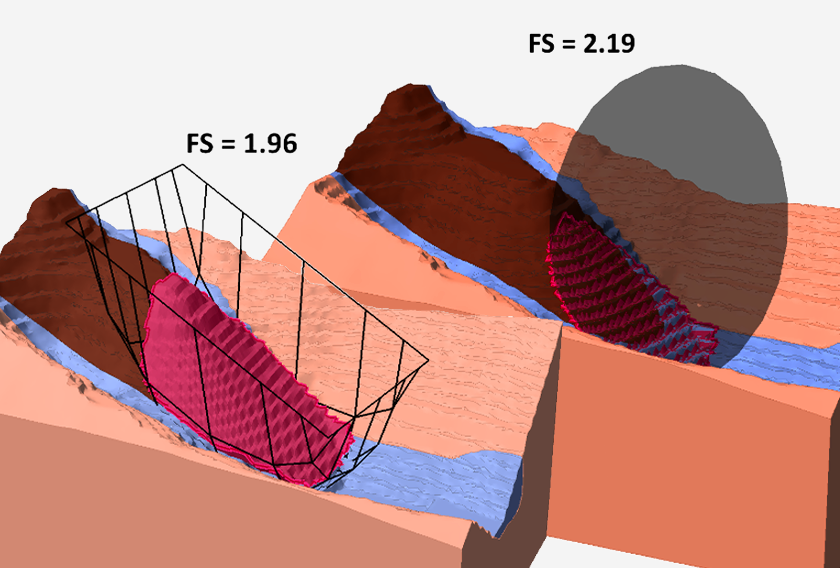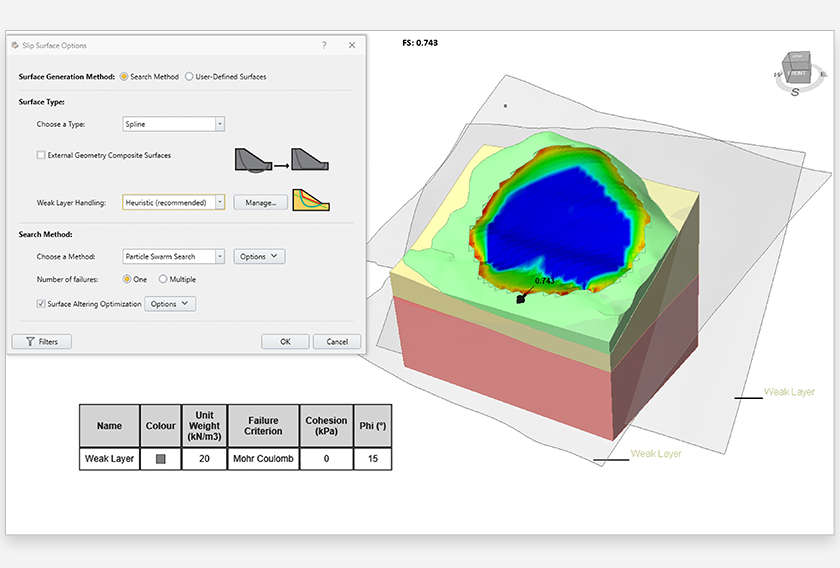The Power of Back Analysis for Managing Slope Instabilities in Weak Rock Masses
Weak rocks due to their low strength and susceptibility to deformation pose risks to slope stability. This is the case of Cerro Corona gold-copper mine in Peru which encountered geotechnical challenges in their eastern and northwestern pit walls due to weak, non-competent (NC) geotechnical units. These units were the primary contributors to multiple slope instabilities.
The Geological Setting
Cerro Corona's mineralization is a cylindrical diorite porphyry body intruding Cretaceous-age carbonate rocks. The transition zones between intrusive and host carbonate rocks are characterized by fault contacts with intense clay alteration and shear zones. These zones predominantly occur along the east and west walls of the pit and are associated with non-competent (NC) geotechnical units, mainly argillic altered rocks and non-competent limestones from the Lower Yumagual and Pariatambo formations.

Challenge: Slope Instability in Transition Zones
In 2021, two significant instabilities occurred on their east wall. These failures involved bench- and multi-bench-scale failures primarily within the transition zones, resulting in non-productive time and safety risks.
The first event (March 2021) involved a fault surface spanning seven benches with a maximum height of 70 m. The failure mechanism was linked to the local fault, contact zone between intrusive and host rock, and the geometry of the slope, which had an inter-ramp angle (IRA) of 44°.
The second event (November 2021) occurred in the same zone and was triggered by the progressive weakening of Argillic 2 Non-Competent (A2NC) material due to abnormal rainfall. The IRA has been reduced to 36° upon the first failure event.

The Solution Approach
1. Back Analysis
Back analysis was performed using our Slide2 and Slide3 software to calibrate geomechanical parameters of the weak A2NC material based on observed failure surfaces and monitoring data.
- The sliding mass was modeled as vertical columns, and the Factor of Safety (FoS) was calculated iteratively to identify the critical failure surface.
- Groundwater was not considered as it lies well below the failure zones.
- Initial analyses assumed homogeneous isotropic soil-like behavior for A2NC.
- The Morgenstern-Price force balance method and Cuckoo Search algorithm were used for determining the slip surface.
Results
- For the first instability with an IRA of 44°, the FoS was 0.97 (2D) and 1.11 (3D), indicating marginal stability.
- The second instability, with an IRA reduced to 36°, showed improved FoS values of 1.12 (2D) and 1.13 (3D).
- The second event’s failure attributed to strength degradation of A2NC due to rainfall was confirmed by back analysis showing reduced cohesion (C=18 kPa) and friction angle (Ø=28°).

2. RS3 Calibration
After determining the parameters of cohesion and friction angle for the instabilities, the slope was modelled using our RS3 software, with the aim of calibrating the properties of the A2NC. Comparison with prism PE_2167 showed RS3 results (115 cm) closely aligned with actual deformation, reinforcing the reliability of the calibrated parameters.

3. Final LOM Slope Stability Analysis
Following the comprehensive drilling campaign and calibration of geomechanical parameters, 3D limit equilibrium analyses were conducted for the life-of-mine (LOM) pit design.
For the remediated critical zone in the east wall, the FoS was calculated at 1.39, exceeding the Cerro Corona acceptability criterion of 1.3, indicating stable conditions (Figure 4). In contrast, the northwest zone, dominated by non-competent units (Argillic 2, Lower Yumagual, and Pariatambo formations), showed a FoS of 1.10 with an IRA of 42°, below the acceptable threshold. Design adjustment recommended to reduce IRA to 37–38° to ensure acceptable safety (Figure 5).


The Verdict
Calibration of 3D stability models using monitoring data and back analysis is critical for reliable design and risk management. Slide3's and RS3’s precise modelling validated against radar data allows for proactive risk management, and in this case, allow agile safety decisions and optimize pit design geometry.


